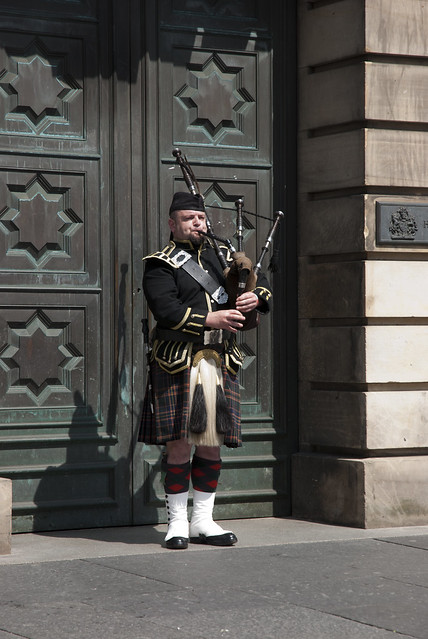Final Thoughts on the Course
I have to admit that there were times before I had my study break and afterwards that I had lost all momentum, enthusiasm and competence for the course and for any progress my skills.
When I first started I was relatively uninhibited and felt that some of the challenges would not too difficult to conquer.
Due to the sudden loss of my father, who had nurtured my first interest in photography and art I was suddenly at a loss for understanding and competence. I had to call for a study break and when I returned I worked at a much slower pace to before. I found covering the ground for the rest of the course was a struggle to maintain my pace and not allow the emotional strain to inhibit my expression.
Without the support structure I also struggled to understand concepts and had to rely heavily on reading to provide support.
The first Assignment, being portraiture, at first appeared to be a simple assignment, however I found straight away that it was a challenge to my skills as I had no concept on how to advise a model on how to move and pose. I was very unhappy with my work the first time around.
I was much happier with the Second Assignment as by then I felt quite comfortable approaching complete strangers, striking up a conversation, discussing how I wanted to photograph them and then taking the final images. When I look back through the images I still feel the comfort and happiness of the day.
Assignment 3 for me was a challenge; with my limited mobility I found it difficult to scout out lots of locations and I could not always access areas that are open to non-disabled people. With the limited surroundings I did spend long periods of time watching how people moved through building spaces and how they used them. I was struck by the quick changes in spaces where one moment they were full and then empty. This helped shape my work for the Assignment.
Again in Assignment 4 I was limited in choice of location and that frustrated me as I had to discard what I think were several good ideas as I just could not physically complete the work. I had to settle on what I now feel is a lesser subject and that due to the frustrations my heart was not quite in my work which meant that the final Assignment suffered a bit.
Without the help from outside sources I would not have been able to complete Assignment 5, having no support structure available and no group to fall back on I was lucky that I was able to call upon some of my wife’s friends who rallied round and assisted in the discussions which helped to shape my final work. I plan to revisit the text for this Assignment before final submission to clarify some of the cultural references as not everyone is au fait with the historical and cultural context.
Building supportive networks
For the most part I was a lone worker and had little or no links with other students. My only contact with other students was through the OCA forums and the Facebook pages. For the rest of the time I had to use my own initiative and bounce ideas around a lot forming argument and counter argument for my own work.
After 2 courses do I know what kind of photographer might I be becoming?
After TAOP I was upbeat and felt that my understanding of art and photography had taken a leap forward. However working through the Assignments I felt that it was coming apart for me. I am physically unable to run around scouting out buildings and locations and due to my limited circle of travel I could only work within that limiting scope. It was only when working on Assignment 5 that I felt more comfortable and that the course was coming together as it was at that point that I felt that I could use the Project to show that there was an inconsistency in the way that people perceive a location based on how it is being presented to them as living history. Here I was leaning into the space of social and cultural photography.
Areas for improvement
Obviously I need to improve and develop generally but there are some aspects that I think need particular attention.
My tutor on People and Place was generous with his suggestions for improvements and pointing me towards photographers that I should view and read.
My tutor give me several suggestions on my last three assignments, cropping images as well as suggesting other images that I could have used. What was positive was that it gave me more ideas for structuring my images and my concept of working to completed project and he also made me consider my editing skills.
Going forward I do need to develop my text and image editing skills. Writing and editing large pieces of text are difficult for me as I suffer badly from dyslexia and I have to rely on someone who has no concept of my working in art to help in making the text comprehensive and complete.
Sunday 14 September 2014
Tuesday 1 July 2014
Cultural History - Clarification
As part of Assignment 5 I used the text Chocolate and shortbread box version of Scotland without really giving a clear cultural clarification and imparting knowledge.
Essentially the Chocolate/Shortbread box version of Scotland is the highland hills and mountains covered in heather and grass usually accompanied with a loch, a highland cow, some tartan or someone playing the bagpipes.
However like many places, this version of Scottish Culture does not really exist outside of the tourist trail. Tartan itself for example was not a popular item within Scotland until Sir Walter Scott made it the must have item
Bagpipes themselves can be traced as far back as a carving on a stone Hittite slab at Eyuk. The history of the bagpipes is convoluted and complex. Some believe that the bagpipes came from the middle east
This version of Scottish Culture is not made clear within the tourist industry as it may well damage the cultural view of Scotland and its past.
Essentially the Chocolate/Shortbread box version of Scotland is the highland hills and mountains covered in heather and grass usually accompanied with a loch, a highland cow, some tartan or someone playing the bagpipes.
However like many places, this version of Scottish Culture does not really exist outside of the tourist trail. Tartan itself for example was not a popular item within Scotland until Sir Walter Scott made it the must have item
Bagpipes themselves can be traced as far back as a carving on a stone Hittite slab at Eyuk. The history of the bagpipes is convoluted and complex. Some believe that the bagpipes came from the middle east
This version of Scottish Culture is not made clear within the tourist industry as it may well damage the cultural view of Scotland and its past.
Bibliography.
Angier, R. (2015). Train Your Gaze: A Practical and Theoretical Introduction to Portrait Photography. United Kingdom: Bloomsbury Academic.
Brunelli, P. G. (2013). Ronnie James Dio A Photographic Memoir by PG Brunelli. 2nd ed. Great Britain: Rufus Stone.
Dance, R. (2012). Hollywood Unseen: Photographs from the John Kobal Foundation. United Kingdom: Antique Collectors’ Club.
Dimond, F. (2004). Developing the Picture: Queen Alexandra and the Art of Photography. United Kingdom: Royal Collection Enterprises.
Dylan, B. and Feinstein, B. (2008). Hollywood Foto-Rhetoric: The Lost Manuscript. First. United Kingdom: Simon & Schuster.
Ewing, W. A. (2007). Edward Steichen. United Kingdom: Thames & Hudson.
Finler, J. W. (2012). Hollywood Movie Stills: Art and Technique in the Golden Age of the Studios. 1st ed. United Kingdom: Titan Books.
Freeman, S. L. and J. (2009). The Illustrated Practical Guide to Digital and Classic Photography: The Expert’s Manual on Taking Great Photographs. London: Hermes House.
Herschdorfer, N. (2012). Coming in Fashion A Century of Photography at Conde Nast. First. Germany: Foundation for the Exhibition of Photography.
Jeffrey, I. and Kozloff, M. (2008). How to Read a Photograph: Understanding, Interpreting and Enjoying the Great Photographers. United Kingdom: Thames & Hudson.
Jenkinson, M. (2011). The Portrait Photography Course. United Kingdom: A & C Black Publishers.
Kirstein, L., Evans, W. and Meister, S. (2012). Walker Evans: American Photographs. 75th ed. United States: Museum of Modern Art.
Margaine, S. and Margaine, D. (2009). Forbidden Places: Exploring Our Abandoned Heritage. France: Jonglez.
Margaine, S. and Margaine, D. (2013). Forbidden Places. France: Jonglez.
Muir, R. (2010). Norman Parkinson: Portraits in Fashion. United Kingdom: Palazzo Editions.
Prakel, D. (2006). Basics Photography 01: Composition. Switzerland: AVA Publishing SA.
Scott, C. (2007). Street Photography: From Brassai to Cartier-Bresson. United Kingdom: I.B.Tauris.
Stevenson, S. and Forbes, D. (2009). A Companion Guide to Photography in the National Galleries of Scotland. United Kingdom: National Galleries of Scotland.
Strauss, D. L. and Berger, J. (2004). Between the Eyes: Essays on Photography. 1st ed. United States: Aperture.
Wilson, D. M. (2011). The Lost Photographs of Captain Scott: Unseen Photographs from the Legendary Antarctic Expedition. United States: Little Brown and Company.
Worobiec, T. and Spence, R. (2003). Photo Art. 2nd ed. Singapore: Amphoto Books.
Brunelli, P. G. (2013). Ronnie James Dio A Photographic Memoir by PG Brunelli. 2nd ed. Great Britain: Rufus Stone.
Dance, R. (2012). Hollywood Unseen: Photographs from the John Kobal Foundation. United Kingdom: Antique Collectors’ Club.
Dimond, F. (2004). Developing the Picture: Queen Alexandra and the Art of Photography. United Kingdom: Royal Collection Enterprises.
Dylan, B. and Feinstein, B. (2008). Hollywood Foto-Rhetoric: The Lost Manuscript. First. United Kingdom: Simon & Schuster.
Ewing, W. A. (2007). Edward Steichen. United Kingdom: Thames & Hudson.
Finler, J. W. (2012). Hollywood Movie Stills: Art and Technique in the Golden Age of the Studios. 1st ed. United Kingdom: Titan Books.
Freeman, S. L. and J. (2009). The Illustrated Practical Guide to Digital and Classic Photography: The Expert’s Manual on Taking Great Photographs. London: Hermes House.
Herschdorfer, N. (2012). Coming in Fashion A Century of Photography at Conde Nast. First. Germany: Foundation for the Exhibition of Photography.
Jeffrey, I. and Kozloff, M. (2008). How to Read a Photograph: Understanding, Interpreting and Enjoying the Great Photographers. United Kingdom: Thames & Hudson.
Jenkinson, M. (2011). The Portrait Photography Course. United Kingdom: A & C Black Publishers.
Kirstein, L., Evans, W. and Meister, S. (2012). Walker Evans: American Photographs. 75th ed. United States: Museum of Modern Art.
Margaine, S. and Margaine, D. (2009). Forbidden Places: Exploring Our Abandoned Heritage. France: Jonglez.
Margaine, S. and Margaine, D. (2013). Forbidden Places. France: Jonglez.
Muir, R. (2010). Norman Parkinson: Portraits in Fashion. United Kingdom: Palazzo Editions.
Prakel, D. (2006). Basics Photography 01: Composition. Switzerland: AVA Publishing SA.
Scott, C. (2007). Street Photography: From Brassai to Cartier-Bresson. United Kingdom: I.B.Tauris.
Stevenson, S. and Forbes, D. (2009). A Companion Guide to Photography in the National Galleries of Scotland. United Kingdom: National Galleries of Scotland.
Strauss, D. L. and Berger, J. (2004). Between the Eyes: Essays on Photography. 1st ed. United States: Aperture.
Wilson, D. M. (2011). The Lost Photographs of Captain Scott: Unseen Photographs from the Legendary Antarctic Expedition. United States: Little Brown and Company.
Worobiec, T. and Spence, R. (2003). Photo Art. 2nd ed. Singapore: Amphoto Books.
Thursday 26 June 2014
Dennis Hopper Exhibition at the Royal Academy
The Royal Academy in London are currently showing the Dennis Hopper "The Lost Album" exhibition
Details are here https://www.royalacademy.org.uk/exhibition/22?gclid=CNiLkIO5mb8CFSjpwgodmlcAzQ
It looks like an exciting collection of images, hopefully it will tour the country and I hope that I will get a chance to see it. I found Dennis Hopper to be a fascinating photographer and this collection of photos of both fellow actors and artists as well as social life in the ever changes times of the 60s and 70s.
I feel that he has a unique perspective on the times and these photos act almost as a visual diary of his experiences.
Details are here https://www.royalacademy.org.uk/exhibition/22?gclid=CNiLkIO5mb8CFSjpwgodmlcAzQ
It looks like an exciting collection of images, hopefully it will tour the country and I hope that I will get a chance to see it. I found Dennis Hopper to be a fascinating photographer and this collection of photos of both fellow actors and artists as well as social life in the ever changes times of the 60s and 70s.
I feel that he has a unique perspective on the times and these photos act almost as a visual diary of his experiences.
Tuesday 17 June 2014
Commonwealth Baton
I noticed a number of signs on the main roads detailing the parking restrictions for the day of the Commonwealth baton relay.
Since it was passing the end of the street I popped along to have a quick look and see if I could get a couple of shots of the relay as it passed.
The first runner past was an official with the Glasgow 2014 mascot, getting people into the mood by cheering as she past.
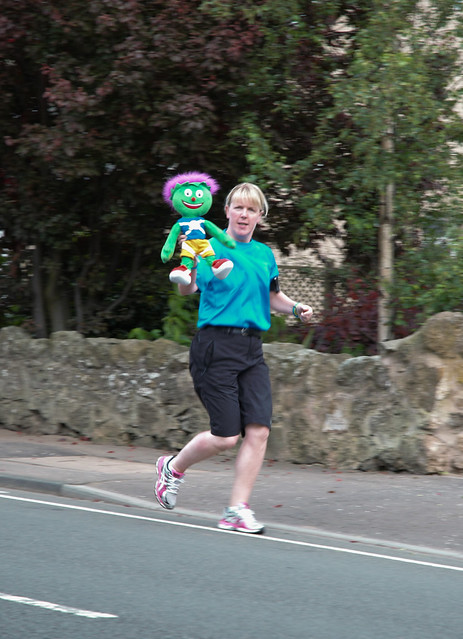
She certainly looked like she was enjoying the run as it was a pleasant enough day, and the relay was short.
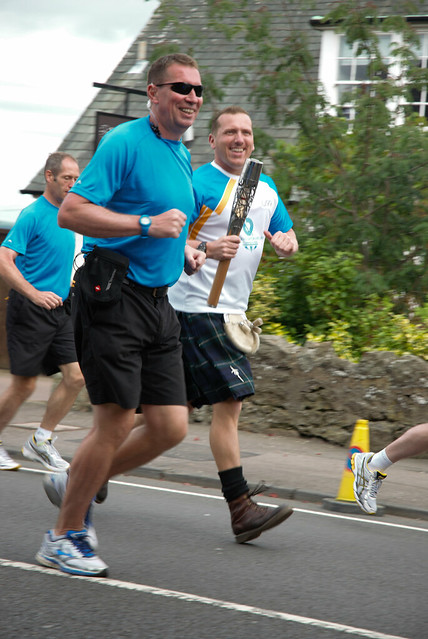
This gent was the first actual runner for this section coming into Haddington as he jogged past he was surrounded by police runners and motorbikes. He got a good response from the crowd as he ran.
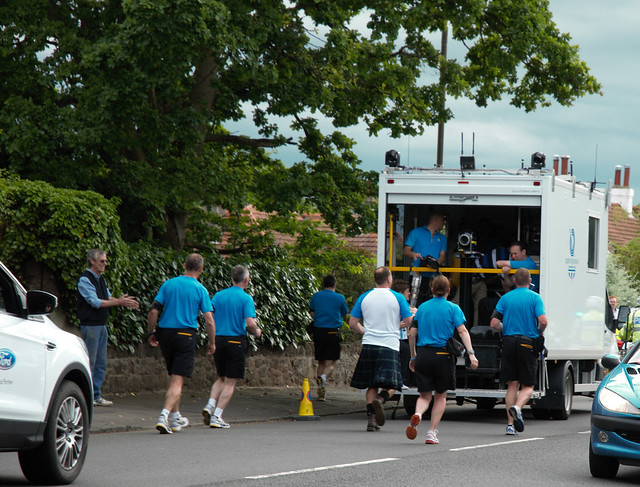
As the van in front past I noticed that it was full of photographers and technical equipment allowing them to broadcast the relay as it happened. There was quite a lot of kit in that van!.
Since it was passing the end of the street I popped along to have a quick look and see if I could get a couple of shots of the relay as it passed.
The first runner past was an official with the Glasgow 2014 mascot, getting people into the mood by cheering as she past.
Baton runner 1
Nikon D80, Aperture Priority Mode, Aperture f5.6, Speed 1/90, 70mm, ISO 125, Daylight White Balance, 18-70mm lens.
She certainly looked like she was enjoying the run as it was a pleasant enough day, and the relay was short.
Baton runner 2
Nikon D80, Aperture Priority Mode, Aperture f5.6, Speed 1/125, 70mm, ISO 125, Daylight White Balance, 18-70mm lens
This gent was the first actual runner for this section coming into Haddington as he jogged past he was surrounded by police runners and motorbikes. He got a good response from the crowd as he ran.
Baton and BBC Van
Nikon D80, Aperture Priority Mode, Aperture f5.6, Speed 1/125, 70mm, ISO 125, Daylight White Balance, 18-70mm lens
As the van in front past I noticed that it was full of photographers and technical equipment allowing them to broadcast the relay as it happened. There was quite a lot of kit in that van!.
Assignment 5 - People and Place on Assignment.
The first thing to decide was what type of client I was going to work for, as this would help define the final images of the Assignment. After some consideration I decided that the client would be a “National Geographic” type magazine. After that I had to decide on a subject for the photo shoot. With a couple of friends, my wife and I role played ideas and bounced subjects and thoughts backwards and forwards with me refining ideas which started to look like they might meet the brief of the subject matter.
I then mulled the ideas around for a couple of days, before returning to the subject of the brief. I went looking for templates, samples and picture briefs so that I could get a structured idea of what a real brief would look like and what would be asked for in the brief; as this would help define the images and ideas that I would shoot.
Again I sat down with friends and we went through the brief with them acting as the magazine and myself as the photographer so that we could firm up ideas and requirements. I had an independent person on the sidelines who was able to guide the brief in the right direction so that we did not judge and set to low or too high a set of objectives.
I referenced a number of websites for guidance on creating a proper brief, these sites included
- · Tilia Services http://www.tiliaservices.co.uk/brief.html
- · DIY Photography http://www.diyphotography.net/photo-licensing-look-basics/
- · Tick Boxer http://www.tickboxer.com/content/tickboxer-faq.htm
- · Smart Insights http://www.smartinsights.com/digital-marketing-strategy/creative-brief-template/
- · Pinterest http://www.pinterest.com/pin/33565959694773242/
- · About.Com http://advertising.about.com/od/tipoftheweek/ht/How-To-Write-A-Creative-Brief.htm
I sat and looked over my notes and decided to try and apply
these notes to a template brief that I had. The template brief I used was from Box
ticker and after a few hours I did find that I was starting to get bogged down
in the template questions themselves. After about 2 days of trying to answer
the questions based on my notes and the ideas that I had in my head I felt that
it was too complicated to complete single handedly. I then went with a template
brief for just image guidance as a brief. The brief was shaped by a web template
by Talia Services (http://www.tiliaservices.co.uk/brief.html)
This was much simpler and guided me towards what I was to capture, as I felt that I was not trying to create a fully detailed article rather just some guidance for myself which would help me capture the images.
I have attached a copy of the completed typed brief so that I can show how the ideas were formed before I decided where and when to photograph.
I did encounter one major speedbump on the way and that was that all my printers in the house stopped working for one reason or another, and I realised that I was completing most of my detailed document editing on paper which I find a lot easier than on computer.
Using the main part of the brief, the idea was for the final article and images to show and focus on the subject of the loss of industrial heritage and history in a small town so close to the capital which thrives on a different style of history. I wanted to show the difference between the chocolate and shortbread box history of the area and the reality of the area where the inconvenient industrial history which is considered “dirty” is not being preserved for the future.
The first thing to do was to scout out some areas that I considered worthwhile investigating and to took a couple of test shots which I published in my learning log to show that I was proceeding with ideas and to show the basic structure of my brief.
I returned to the site I had chosen often to photograph again and again in different lighting conditions to get the images that I wanted. I did not want a complete set of dark dank photos of rotting metal and wood, I wanted to show the “museum” as it is called in the full light of day and reveal what is happening to it and to the surrounding locations.
After the initial investigation and shoots I then refined a few ideas and returned to see if I could continue to shoots ideas in a contiguous method where I could bring the strands together into a final article.
Once I had a large number of images, I started to refine them down by comparison of each image to check not only if it met with the brief but would be suitable for publication within an article. As I built the ideas together I used a latin Loreum document filled with text so that I could adjust the position of each image in relation to both the text and to each other.
Cover
Nikon D80, Exposure Mode Manual, focal length 18mm (35mm
equivalent 27mm), aperture f22, speed 1/4 second, ISO 100, Daylight white
balance, Centre Weight metering, Tripod Mounted Camera, 18-70mm lens
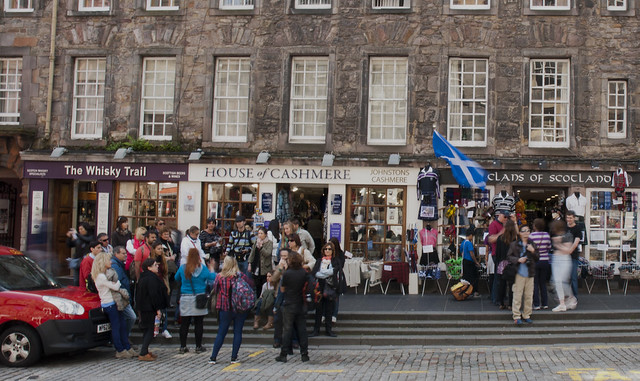
In trying to capture the contrast between what I saw at the
museum and what I saw on the street I wanted to show the ever present tartan
shortcake box faux image of the area and provide evidence that visitors are
being guided and presented with a distorted image and history.
I thought that this was an ideal cover image as it presented the group of individuals and a guide standing in front of a row of Tourist shops while the guide was giving a short presentation. I was happy to see that a couple of the people were so engrossed in the tale that they were unaware of their surroundings and were sitting on the van bonnet and standing in the street where traffic passes.
From historical images I discovered that this particular area was in fact originally housing and entranceway for the apartments above.
Abandoned Lighthouse /DSC_0010
Nikon D80, Aperture Mode Manual, focal length 50mm (35mm
equivalent 37mm), aperture f13, speed 1/125 second, ISO 250, Daylight white
balance, Matrix metering, Hand Held Camera, 50mm prime lens,

I wanted to capture this lighthouse as it is situated right
at the far end of what was originally a dockland wall but is now recovered land
used for modern luxury building. The lighthouse has been left to rot and
vandalised even though it sits only a few hundred feet from a major tourist
attraction and shopping centre.
Left to Vandals/ DSC_0018
Nikon D80, Aperture Mode Manual, focal length 11mm (35mm equivalent 16mm), aperture f13, speed 1/125 second, ISO 250, Daylight white balance, Matrix metering, Hand Held Camera, 11-16mm lens,
I had to balance on what was left of a seawall and platform to get to this section of the lighthouse. I could only shoot through the fence, so I composed the frame to show the dirt and debris remaining and that the building has just been left to vandals.
Coal
Wagon Left to rot/DSC_0096
Nikon D80, Exposure Mode Auto, focal length 29mm (35mm equivalent
43mm), aperture f4.8, speed 1/60 second, ISO 400, Shade white balance, Matrix
metering, Hand Held Camera, 18-70mm lens,
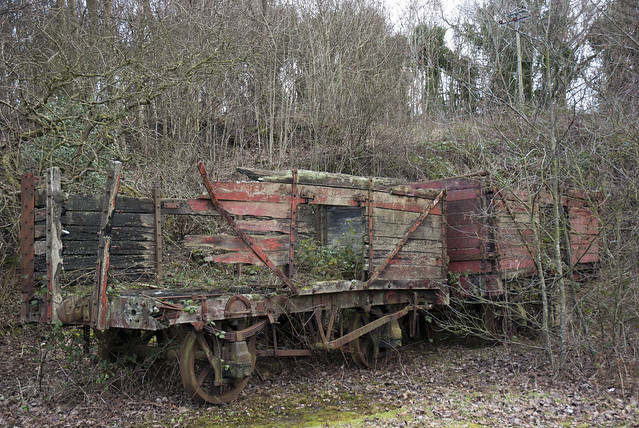
Here I started to wander around the museum and found that
items had been abandoned to the elements. An old coal wagon which would have
been used to transport coal up and down the coast has been pushed into the
embankment and left. It lies a stone’s throw from the museum but has been
allowed to sit and become overgrown with bushes and plantlife has started to
grow on the rotting wood itself.
When this image was shown to a local historian and archaeologist he was both surprised and disgusted that a museum would allow exhibits to rot and that the technology and style of this wagon was being lost forever.
Places still to hide/ DSC_0110
Nikon D80, Aperture Mode Manual, focal length 18mm (35mm equivalent 27mm), aperture f4, speed 1/125 second, ISO 400, Shade white balance, Matrix metering, Hand Held Camera, 18-70mm lens,
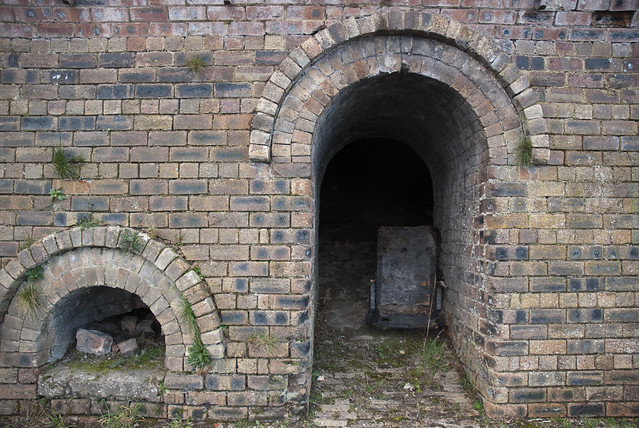
Sited beside the museum is the brickworks, fenced off from
the rest of the land. People still come and climb the fence and hideout and do
whatever they feel like. This burnt chair caught my eye as I walked past. It
was obvious that it had not been there long and that someone had still used it
for shelter. I liked the colours of the wooden parts of the chair as they
mirrored to colour of the bricks surrounding it.
Waterlogged Brickworks/ DSC_0127
Nikon D80, Aperture Mode
Manual, focal length 18mm (35mm equivalent 27mm), aperture f4, speed 1/350
second, ISO 400, Shade white balance, Matrix metering, Hand Held Camera,
18-70mm lens

For this image, I had to shoot over the fence holding the
camera above my head. I was standing at the end of the line of the brickworks,
behind me would have been a wooden , steel and brick ramp leading down to the
mixing ponds and the final stacking area. You can clearly see the design of the
brickworks as it leans back into itself to guide the heat and smoke back
towards the chimney. Now nothing runs down the tracks but rain.
Beam Engine/ DSC_0147
Nikon D80, Aperture Mode
Manual, focal length 18mm (35mm equivalent 27mm), aperture f4, speed 1/350
second, ISO 400, Shade white balance, Matrix metering, Hand Held Camera,
18-70mm lens
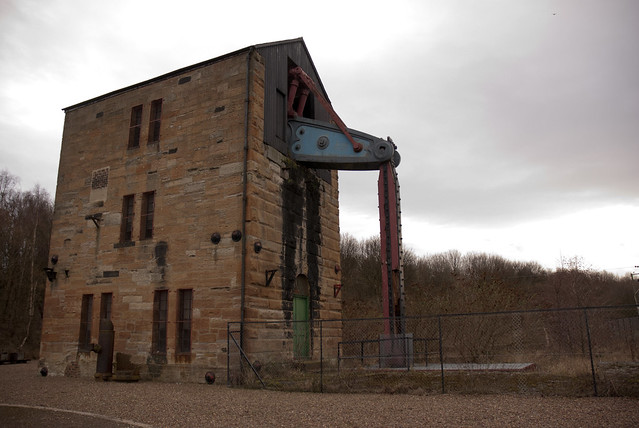
Standing
high above everything else is the beam engine which was used to pump water and
clay up from the mines and out into the brickworks. It was originally slated
for complete restoration and repair and was going to be one of the few beam
engines still running. However that idea, like the engine, has been abandoned
and now stands unused and unnoticed as the landscape. I wanted to capture the
size of the building and the fact that it now stands silent rusting slowly.
Train Crane/ DSC_0157
Nikon D80, Aperture Mode
Manual, focal length 50mm (35mm equivalent 75mm), aperture f4.5, speed 1/1000
second, ISO 400, Shade white balance, Matrix metering, Hand Held Camera,
18-70mm lens
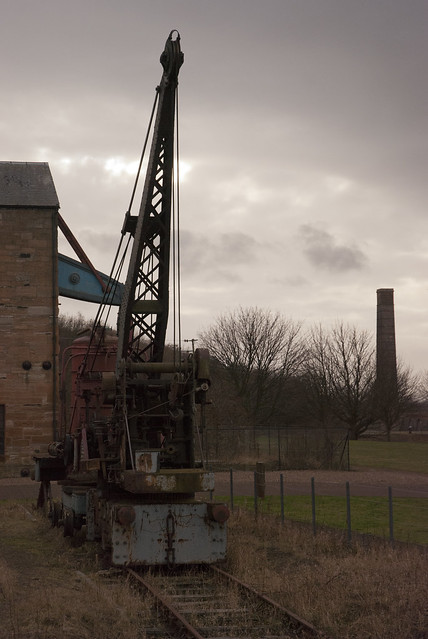
This crane was being used by the enthusiasts when they first started the idea of the museum to repair and rebuild the steam locomotives which were sat around the site. These locomotives are no longer here and the only sign that they existed is now this train crane. It sits on rusting rails no longer being considered for repair or conservation. Like the locomotives one day it will be no more than a piece of metal sitting amongst the rubble.
Rusting Rails/ DSC_0160

Once these lines were used for the transport of the coal and bricks out of the yard and up to the main train line where they would be transported up to Edinburgh and beyond. When the steam trains were still being run once a month, these lines were used to run the trains back and forth for the pleasure of the locals and for train enthusiasts further afield. Now they end in a wire fence and the rails are broken and loose.
Airshaft Cap/ DSC_0041
Nikon D80, Aperture Mode
Manual, focal length 11mm (35mm equivalent 16mm), aperture f4, speed 1/750
second, ISO 100, Daylight white balance, Matrix metering, Hand Held Camera,
11-16mm lens
This is the top of an airshaft, which was sunk to provide
air to the lower part of the mines and for access to the top of the shaft for
maintenance. Like the rest of the area it sits unattended and is vandalised on
a semi regular basis.
After shooting the images for the museum I wanted to capture some contrasting images, the types of images that the shortbread box version of the area which is well advertised and subscribed to by the tourist board.
I had to wait a few weeks to complete these images as between spells of terrible weather I had to endure a change is medication and a bout of bursitis in my right shoulder left me unable even to left a camera.
Finally I was able to go to the one location that I wanted which was the top of the Royal Mile in Edinburgh, where the original view of the castle is now blocked by the advertising boards for the Edinburgh Tattoo. My concept was to photograph a local street artist who dresses akin to the Hollywood version of William Wallace, but his usual location was taken by someone else and he was unavailable to photograph.
I moved down the street and photographed my second choice which is a row of shops selling the usual collection of tartan everything.
I also photographed shop workers dressing in kilts as they passed on their way to work.
Tourist Board
Nikon D80, Aperture Mode Manual, focal length 65mm (35mm
equivalent 97mm), aperture f11, speed 1/180 second, ISO 1000, Daylight white
balance, Centre Weight metering, Hand Held Camera, 18-70mm lens,
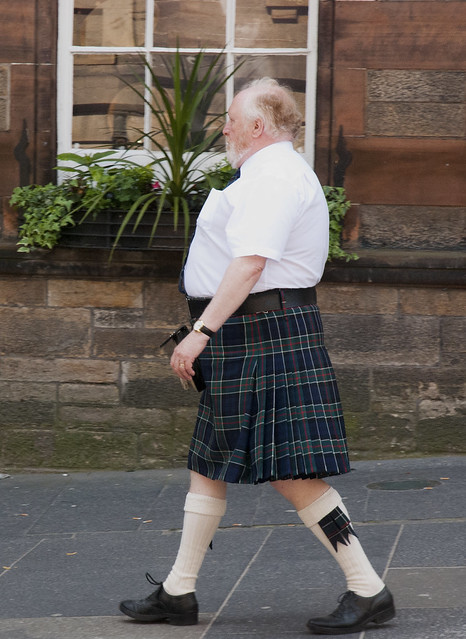
I
wanted to capture the kilt and sporran image of the tourist board workers; they
wear a specially designed tartan which was created in 2003 for the Visit
Scotland organisation.
I really wanted to capture the complete contrast in the two locations, one where the history has been lost and discarded and the other being perpetuated and enforced.
Piper
Nikon D80, Exposure Mode Manual, focal length 70mm (35mm
equivalent 105mm), aperture f8, speed 1/125 second, ISO 1000, Daylight white
balance, Centre Weight metering, Hand Held Camera, 18-70mm lens,
As always, there is the ever present piper in full military regalia somewhere posing and piping for the passersby. Here the piper stands with his back to a large bronze door where he could continue to play while people came and stood beside him to be photographed.
I went
into this assignment with the hope that I would gather some surprise images and
feel that the images I captured would present a hopeful view that these
locations could be saved. , However as I set out to write up the assignment I
feel a sort of loss that these places are being abandoned and that people no
longer care for them and that they are nothing more than places to vandalise or
walk their dogs.
Have I
completed what I set out to do? Yes I feel that I have fulfilled the brief, I
have taken images which have already produced feelings and statements from
several viewers.
What
have I learned throughout this course; People photography is a lot
harder than I thought.
My self confidence really needs to be built up, at the
moment having only started, my confidence and self security in photographing in
this style is a lot lower, but in saying that I have only started and the
experience from this course has helped shape my thoughts and ideas.
I am still struggling in focusing my emotional depth, at
times I miss a good shot as I have not fully considered the emotions and
thoughts behind the image.
Saturday 14 June 2014
Sensor Dust
Due to a small section of the house having to be refurbished I have not had regular power or internet access and I was unable to check some of my assignment images until long after I had taken them.
Imagine my horror when I discovered that some of the images were completely ruined by sensor dust. Large unfocused blobs and spots could be clearly seen in some of the images and where they they had caught the light looked like lens flares.
Having not cleaned the sensor on the D80 for a while I found that some of the spots were difficult to remove. Following the guidance on the web, I purchased a lupe with the light that I could sit on the camera body and this would allow me to see, analyse and guide me on where I had to clean the sensor.
Having used some new sensor cleaning tools I was nervous to see if the sensor was clean and the images less spotted.
On first review I was horrified to see that there were some smears and spots which looked worse than before. After a second clean with the tools, and air duster and using a small vacuum pump to draw air away from the body I was pleased to see that the sensor was at least cleaner.
Rose Macro
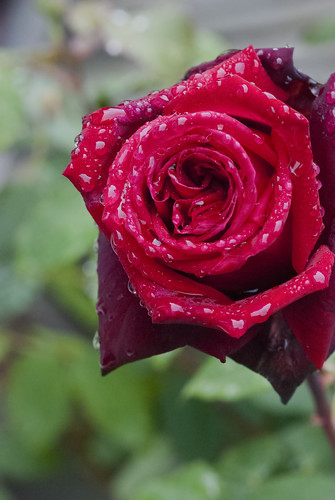
Imagine my horror when I discovered that some of the images were completely ruined by sensor dust. Large unfocused blobs and spots could be clearly seen in some of the images and where they they had caught the light looked like lens flares.
Having not cleaned the sensor on the D80 for a while I found that some of the spots were difficult to remove. Following the guidance on the web, I purchased a lupe with the light that I could sit on the camera body and this would allow me to see, analyse and guide me on where I had to clean the sensor.
Having used some new sensor cleaning tools I was nervous to see if the sensor was clean and the images less spotted.
On first review I was horrified to see that there were some smears and spots which looked worse than before. After a second clean with the tools, and air duster and using a small vacuum pump to draw air away from the body I was pleased to see that the sensor was at least cleaner.
Rose Macro
Nikon D80, Aperture Mode Manual, focal length 105mm (35mm
equivalent 157mm), aperture f8, speed 1/500 second, ISO 3200, Daylight white
balance, Matrix metering, Hand Held Camera, 105mm macro lens,

Monday 5 May 2014
St Abbs
To help me chill out a little, it was suggested that Linz and I join Em and Nick down at St Abbs as they were going to practice some snorkelling and that would allow me to photography freely as well as allow me to wander around the area.
I decided to get a few shots of them as they prepared to go out
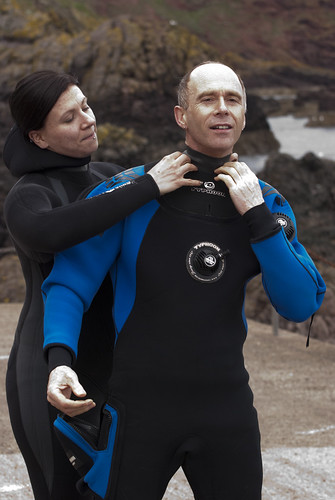
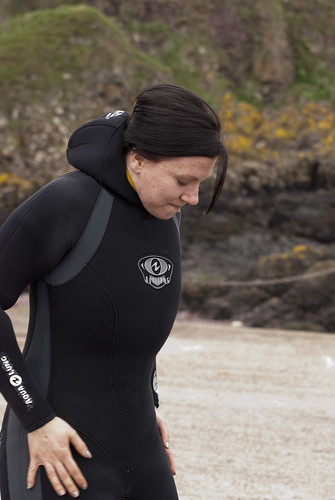
Then a couple of shots as they were in the water
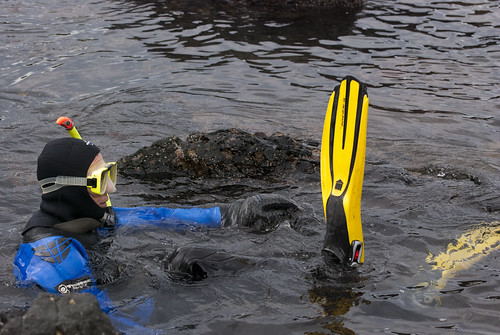

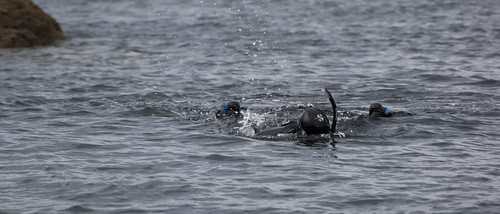
Before coming back to dry land and get ready to head back.

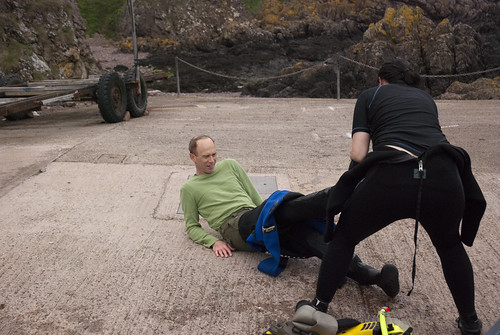
I managed to climb the seawall and get a number of shots so that I could combine them into this panorama. I got them all just as the clouds started to roll in.
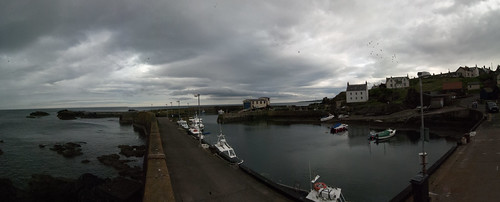
Of course when we got home we got the usual warm welcome.
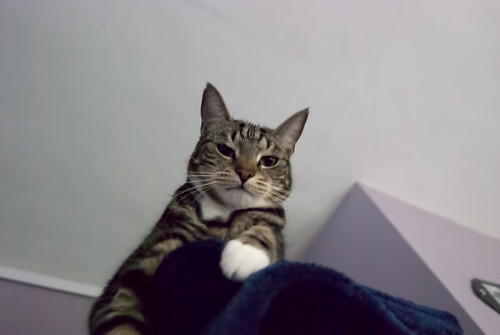
I decided to get a few shots of them as they prepared to go out


Then a couple of shots as they were in the water



Before coming back to dry land and get ready to head back.


I managed to climb the seawall and get a number of shots so that I could combine them into this panorama. I got them all just as the clouds started to roll in.

Of course when we got home we got the usual warm welcome.

Sunday 13 April 2014
Test Shoots for Assignment 5
One of the subjects I am considering for assignment 5 is the
lack of historical preservation of the industrial heritage of the area. There
are a number of areas which were historically important which are now being
left abandoned or build destroyed and built around.
I first noticed this abandoned lighthouse while standing
overlooking the royal yacht Britannia. In this distance at the end of what was
originally as seawall stands this lighthouse. The seawall and harbour bay have
been filled in and now new expensive housing is being built almost right up to
the lighthouse.
Lighthouse
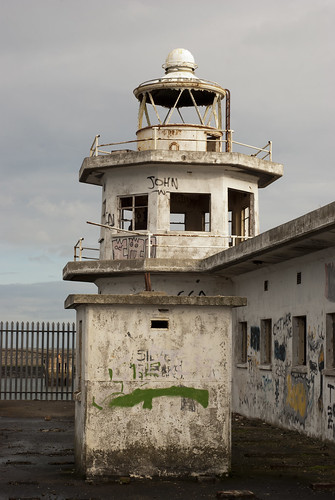
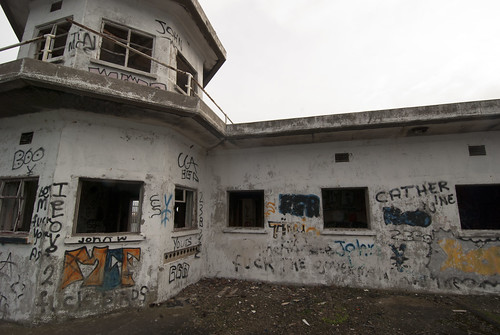
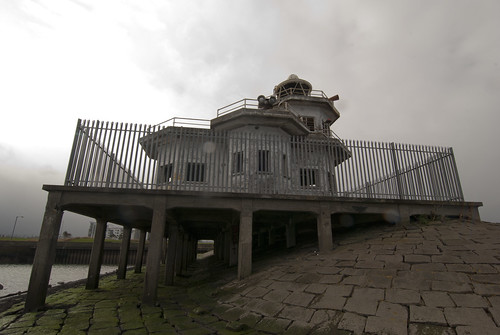
Beers Below
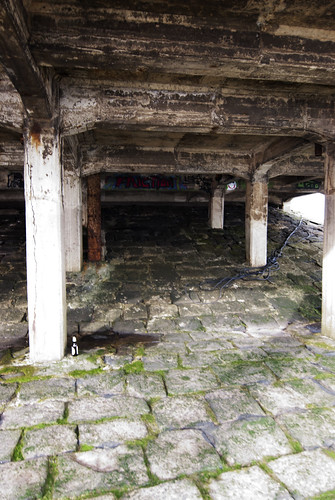
Statue at end of Pier
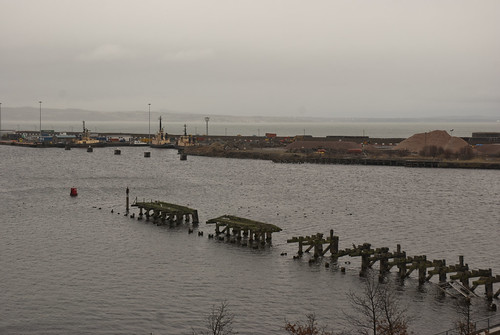
Mining Museum
Further along the coast is what is left of a mining museum, a lot of the items on display are now beginning to rot and rust. The trains, trucks and tracks that I remember as a child have almost all disappeared and the beam engine which used to stand proudly in the centre of the grounds now sits like a wounded dinosaur, a blot on the landscape ignored by locals and passers-by alike.
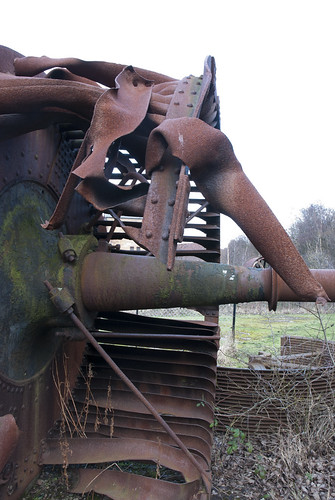
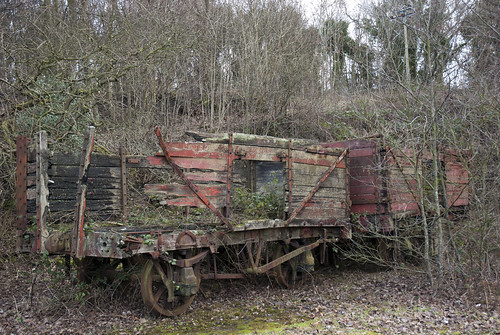
Brickworks
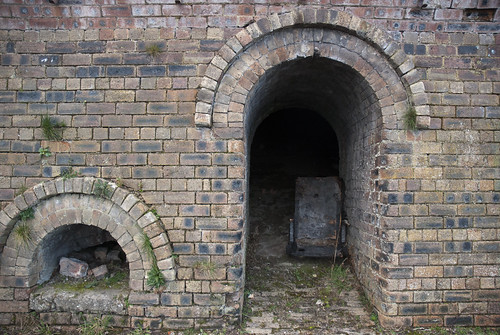

Beam Engine
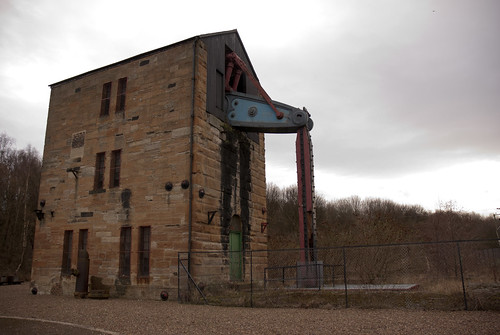
Happy Boiler?
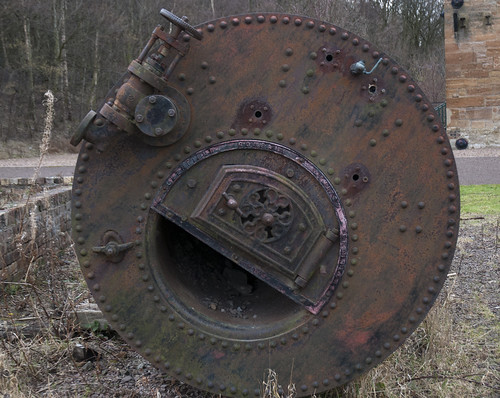
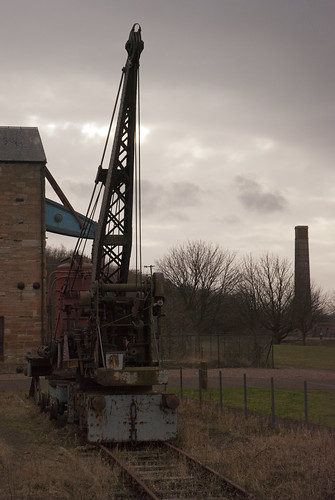

Monday 24 March 2014
Response to Tutors Comments for Assignment 4
Thank you for your feedback. I have to say that I was very
disappointed with your comments.
After deciding that the original set of images did not gel, I went back to my notepad and looked over the previous notes I had made on similar ideas for this Assignment.
On reviewing the set of notes and ideas for Haddington, I then journeyed through the town to each of the locations that I had previously noted, discarding some as although I felt they fitted the brief, they did not make a cohesive grouping. The fact that I was lucky enough to gather over 20 suitable images during that day did not mean that I wandered around with no preconceived plan, the notes that I had made pointed me directly to the locations where I wanted to be. Due to my mobility issues, the actual journey was planned with almost military precision. I have to make sure that when I go out on a shoot, I do not overdo things and cause myself pain. My route is planned and timed so that if I am late then someone knows to come looking for me. As I was on my own for this shoot, I had to limit the equipment to that which I could feasibly carry and in this case, a tripod was too heavy.
For Image 1 I deliberately chose f22 as I was using a
11-16mm lens. Previous experience with the lens had already prepared me for
shooting at f22 as I knew the camera speed could go as low as 1/20th
of a second before I would introduce hand held camera shake. I used f22 as I
wanted to keep everything in sharp focus including the reflection in the river.
Had I used f/8 I would have lost definition and colour in the reflection.
Had there been extra notes in the assignment asking for a
cover image I would have adjusted the setup and shot the image with extra space
within the frame, however nothing was detailed in the brief regarding a cover
image so that was not considered. Before undertaking this assignment, I perused
other students’ assignment submissions to ensure I was not copying an idea of
misinterpreting the brief. I was not aware of cover images or conclusion images
in all the works I saw.
Image 2. I used my knowledge of the camera and the lens for this image. Because the lens has built in shake reduction I could choose the f stop that I wanted so that I could get all of the subjects in sharp focus. Allowing the lens to assist meant that I did not have to select exposure mode and could instead remain on aperture mode. This enabled me to capture what I wanted rather than allowing the exposure to control the speed.
Image 3 I wanted to capture the quietness of the moment and
the fact that the elderly gentlemen was sitting on the bench, keeping himself
to himself. He was so engrossed in his reading of the newspaper that he did not
interact with passers-by; which included the family going to feed the birds, the
cyclist and the dog.
Image 4. I appreciate that this image is relatively common, however I felt it captured the common nature of the activity, which is carried out regularly by many different folk in the area, showing ‘people in action’. The timing of the shot was dictated by the starting time of the game.
Image 5 shows that the river path is no longer used as the main transportation path into the town and has now become a byway used by dog walkers and people undertaking exercise. It has gone from being a part of the town’s business to being part of the town’s leisure.
Image 6. This picture was not specifically planned. Although I had intended to take an unobtrusive, street photography style image (people unawares), I had not known of the charity event taking place, nor that there would be live cartoon characters would be in the town square. As such, I took the image as it arose, spontaneously. I took a couple of images in quick succession and the image chosen, was, in my opinion, the best one.
DSC_0072. I chose not to include this image in the final six because I felt that conveyed emptiness and a lack of use which is not what I feel is happening in the area. I felt that the peace and quietness of the elderly gentleman in image 3 showed relaxed usage rather than abandonment.
Saturday 8 March 2014
Assignment 4 - A Sense of Place
What: The main brief of this assignment was to draw together
ideas and experiences covered in the course so far and produce six images of a
location in the style of a thought provoking publication.
Where: The Town of Haddington.
When: Midmorning
How: I undertook research of several locations. After
photographing and collating one set of images I decided that they did not gel
so I changed location and shot the town of Haddington.
I decided that I wanted to capture images that
provoked an emotional response in me. I moved from place to place and waited
until I saw something that I felt that I wanted to capture within the context
of the assignment.
What I wanted to achieve was to capture the
peacefulness of Haddington even though it is an expanding and busy market town.
I wanted to show that a lot of the activity takes place in one of two locations
- either around the main street at the town’s Corn Exchange or along the river.
The river was one of the first sources of industry
in the town. At one time Haddington had a large wood industry and a large mill
and waterwheel to grind the grain that was then traded in the Corn Exchange.
The town itself is carved into two by the river and is crossed at various
points by small bridges.
I think I succeeded well in capturing the town,
showing that even though it has lost the mills and the heavier industry, the
spirit of the town still survives and people now use the river for
entertainment and pleasure.
Just beside the bridge the river runs past The Waterside Bistro. This building was originally a coach house, inn and shops before being renovated and is now a popular bar and restaurant.
DSC_0211
The bright white of the building reflects in
all manner of sunlight and produces a lovely reflection in the river nearly all
year round. It always makes me happy when I pass to see the reflection in the
calm path of the river.
The river provides a relaxing spot for people to pass time either by feeding the swans and ducks or by sitting peacefully by the water’s edge reading a newspaper.
The river provides a relaxing spot for people to pass time either by feeding the swans and ducks or by sitting peacefully by the water’s edge reading a newspaper.
DSC_0037
Nikon D80, Aperture Mode Manual, focal length 55mm (35mm
equivalent 82mm), aperture f4.5, speed 1/2000 second, ISO 400, Daylight white
balance, Matrix metering, Hand Held, 18-70mm lens,
I really wanted to capture the excitement of
the children as they fed the birds, each child trying to outdo the others and
feeding their favourite bid.
As I moved along the river path I encountered a gentlemen sat for a while reading a newspaper and it reminded me of my dad who used to do the same when on holiday in his caravan.
As I moved along the river path I encountered a gentlemen sat for a while reading a newspaper and it reminded me of my dad who used to do the same when on holiday in his caravan.
DSC_0054
Nikon D80, Aperture Mode Manual, focal length 300mm (35mm
equivalent 450mm), aperture f5.6, speed 1/1000 second, ISO 1000, Daylight white
balance, Matrix metering, Hand Held Camera lent against tree trunk, 70-300mm
lens,I chose to use the telephoto as I did not want to disturb him as he looked like he just wanted to sit quietly and pass time on his own. At first I thought the hat on the end of the bench was his but realised that it had been left there by someone else, probably found in the path and left there just in case someone came looking for it.
During the historical period known as the 'Rough Wooing' there happened a siege of Haddington and soldiers from the French village of Aubigny came to support the Scottish troops. Due to this link the two locations were twinned in 1965. Since the twinning, Haddington has had a resurgence and interest in sport and the Aubigny Sports centre and grounds, which were built as a result of the twinning are now used regularly by local schools and the public.
DSC_0074
The sports centre sits beside the river and there are always dog walkers, runners and cyclists using the old tow path which runs parallel to the watercourse. Here a cyclist takes their dog out for a run along the river path which runs through the town out to the east and west of the town. The dog looked like it was having the time of its life as it ran long.
DSC_0071
I cropped this image down as the dog and the cyclist were too far in the background and were too small; the balance of the image was on the path and the trees rather than on the intended subjects.
DSC_0095
Nikon D80, Aperture Mode Manual, focal length 56mm (35mm
equivalent 84mm), aperture f8, speed 1/30 second, ISO 100, Shade white balance,
Matrix metering, Hand Held Camera, 18-70mm lens,
I liked the fact that the small child showed no fear
initially and was pulling her parent toward Minnie before being distracted by
the fountain. One of the other children pulled her mobile phone and
photographed Minnie as they approached and then photographed the smaller girls,
their parent and Minnie with the backs against the fountain.
I found it quite difficult to reduce my final
selection to six images as I found I was having difficulty giving the full
sense of place of the town. In the end I had to choose to remove a couple of
images that while I found them ideal artistically they did not fit into the
brief.
There was a missed opportunity to capture an image of
Haddington at its busiest during the school drop off and pickup periods as this
is when most people are out and about, as now being a commuter town the town centre
itself can be very quiet during the day even at weekends.
I have added the other six images at the end of this
assignment.
If I had been taking images for no end result I may
have spent more time on the smaller botanical area in town which is full of
plants and insects and not so many people. I would also have spent more time within
the town limits capturing the passing people. I would have also spent more time
photographing in internals and externals of the buildings. The final collection
of images would probably not be quite so focused as they are.
DSC_0013
Nikon D80, Aperture Mode Manual, focal length 11mm (35mm
equivalent 16mm), aperture f5.6, speed 1/1500 second, ISO 400, Daylight white
balance, Matrix metering, Hand Held Camera, 11-16mm lens,
DSC_0072
Nikon D80, Aperture Mode Manual, focal length 18mm (35mm
equivalent 27mm), aperture f5.6, speed 1/1500 second, ISO 1000, Shade white
balance, Matrix metering, Hand Held Camera, 18-70mm lens,
I liked the
sense of silence and quietness this image gives, but it also gives a sense of
abandonment and emptiness that I found jarring.
DSC_0081
DSC_0092
Nikon D80, Aperture Mode Manual, focal length 44mm (35mm
equivalent 66mm), aperture f4.5, speed 1/180 second, ISO 1000, Shade white
balance, Matrix metering, Hand Held Camera, 18-70mm lens,
DSC_0194
Nikon D80, Aperture Mode Manual, focal length 11mm (35mm
equivalent 16mm), aperture f11, speed 1/180 second, ISO 400, Shade white
balance, Matrix metering, Hand Held Camera, 11-16mm lens,
I really liked
the colour of this image as the reflections from the building opposite really
brighten up an overcast location. However the lack of people within the image
means that the image is not quite suitable.
DSC_0205
Nikon D80, Aperture Mode Manual, focal length 56mm (35mm
equivalent 84mm), aperture f5.6, speed 1/750 second, ISO 400, Daylight white
balance, Matrix metering, Hand Held Camera, 18-70mm lens,
I liked this image as it showed the bridge in use,
but I felt that the final six all met the brief better.
Tuesday 4 March 2014
Exercise 23 - Selective Processing and Prominence
What: The main brief of this exercise was to take an image from
a previous exercise and using processing software adjust the image to make two
versions of the image.
Where: Image used was from the Chinese Lantern Exhibition
When: Late evening.
How: I chose
the image as I felt that I could adapt it well using processing software to
create two versions of the image. One giving promenance to the figures in the
settings and the other making the settings stand out.
I really wanted to keep the image as
unprocessed as possible, I did not want to go mad with adjusting brightness,
contrast, selective colour, colour intensity.
As the images I used were Jpeg only as
these are the only type of images produced with the camera I did not want to
process them too much as I knew that it could spoil the image quite quickly.
SUNP005-2
Bonzart Ampel Tilt Shift Camera, Aperture Mode Auto, focal length
9mm (35mm equivalent 9mm), aperture f2.8, speed 1/30 second, ISO 100, Auto
white balance, Multi Mode metering, Tripod mounted camera, 9mm lens,
By adjusting the colour intensity and contrast slightly I have
given the image a higher range of colour. I did not want to make the image too
bright as I did not want to over expose the lanterns and blow out the colour
making them bright blurs. In this case I balanced the colours of the lanterns
against the backgrounds and tried to bring out the colour of the jackets of the
individuals giving them prominence against the background.
SUNP005-4
Bonzart Ampel Tilt Shift Camera, Aperture Mode Auto, focal length
9mm (35mm equivalent 9mm), aperture f2.8, speed 1/30 second, ISO 100, Auto
white balance, Multi Mode metering, Tripod mounted camera, 9mm lens,
By adding a slight gradiated filter to the background I have
brought down the contrast and brightness of the top of the buildings in the
background. This has made the background much darker and suddenly it takes on a
greater prominence in the image as it looms over the courtyard and the people
below.
I was quite surprised by this exercise as I did not think it was quite
as easy to adjust the prominence of the foreground and background in such a
way. It made me view the final image quite differently as the background was
just that a background to the first image.
Exercise 21 - Making Figures Anonymous
What: The main brief of this exercise was to use certain
techniques to photograph a person or persons making them anonymous and less
prominent than the area that they are in.
I noticed a number of people walking backwards and forwards over a high gantry way between two parts of the building. Part of the structure had vertical slats on it and as people walked past it gave them a zoetrope style of movement. I waited until one of the people started to walk back and I captured them as they passed between the slats, partially obscuring them from view. I like fact that they are shadow like and by pushing into the partial view that they are phased out of the image and that the attention is given to the location rather than the individual.
I was watching the visitors as they milled around the car at the entrance of the building. The car is one of the formula 1card driven by a childhood hero who I discovered was also very dyslexic. I wanted to take a long exposure showing motion blur as I wanted to capture the different lengths of time that people stopped at the car. Motion blur also makes them anonymous pushing the balance over to what they are looking at rather than the people themselves.
Here I attempted to combine motion blur with multiple exposure using a fast strobe flash. Unfortunately all that happened was that the fast strobe blurred the image more than I expected, perhaps if the camera had been better supported and the location darker it may have made a difference.
Where: Various Locations
When: Differing times.
How: While
out photographing other exercises and other practices I kept an eye out for
situations where I could photograph people making them anonymous against the
background of the location that they were in.
I chose these photographs for the exercise as
I feel that they work very well in making the people within the images
completely anonymous and indistinguishable against the foreground of the image.
I liked how doing this exercise forced the people into the background and made
the balance of the image weigh towards the surrounds rather than the people.
DSC_0032
Nikon
D80, Aperture Mode Manual, focal length 25mm (35mm equivalent 37mm), aperture
f9.5, speed 1/45 second, ISO 3200, Shade white balance, Spot metering, Beanbag
mounted camera, 18-70mm lens,
I really like this staircase, the way
that the lines are out of balance with the rest of the building gives me a
small happy feeling. I just like the out of kilter perspective of the image.
Here the person is walking up the
stairs their back is the camera and they are also small against a large space. The
fact that you cannot see the persons face means that you have to apply your own
experience of the location to them. In this case I believe the person was
enjoying the location.
DSC_0034
Nikon D80, Aperture Mode Manual, focal length 70mm (35mm
equivalent 105mm), aperture f9.5, speed 1/90 second, ISO 3200, Auto white
balance, Spot metering, Hand Held camera, 18-70mm lens,
I noticed a number of people walking backwards and forwards over a high gantry way between two parts of the building. Part of the structure had vertical slats on it and as people walked past it gave them a zoetrope style of movement. I waited until one of the people started to walk back and I captured them as they passed between the slats, partially obscuring them from view. I like fact that they are shadow like and by pushing into the partial view that they are phased out of the image and that the attention is given to the location rather than the individual.
DSC_0035
Nikon D80, Aperture Mode Manual, focal length 52mm (35mm
equivalent 78mm), aperture f27, speed 15 seconds, ISO 100, Auto white balance,
Spot metering, Bean bag mounted camera, 18-70mm lens,
I was watching the visitors as they milled around the car at the entrance of the building. The car is one of the formula 1card driven by a childhood hero who I discovered was also very dyslexic. I wanted to take a long exposure showing motion blur as I wanted to capture the different lengths of time that people stopped at the car. Motion blur also makes them anonymous pushing the balance over to what they are looking at rather than the people themselves.
DSC_0062- A failed experiment
Nikon D80, Aperture Mode Manual, focal length 52mm (27mm
equivalent 40mm), aperture f19, speed 2 seconds, ISO 3200, Flash white balance,
Spot metering, Hand Held camera, 18-70mm lens, Strobe flash
Here I attempted to combine motion blur with multiple exposure using a fast strobe flash. Unfortunately all that happened was that the fast strobe blurred the image more than I expected, perhaps if the camera had been better supported and the location darker it may have made a difference.
DSC_0115
Nikon D80, Aperture Mode Manual, focal length 50mm (35mm
equivalent 78mm), aperture f1.8, speed 1/500 second, ISO 800, Auto white
balance, Spot metering, Hand Held camera, 50mm lens,
While photographing the Chinese lanterns
exhibition I noticed that I could silhouette people against the lanterns if
correctly composed. I tried a number of shots before this obtaining this image.
Here the figure is silhouetted against the lanterns and the reflections of the
lanterns and has almost disappeared against the light. The person body shape
almost mirrors the stance of the figures that she is observing.
SUNP005
Bonzart Ampel Tilt Shift Camera, Aperture Mode Auto, focal length 9mm
(35mm equivalent 9mm), aperture f2.8, speed 1/30 second, ISO 100, Auto white
balance, Multi Mode metering, Tripod mounted camera, 9mm lens,
I really wanted to try using a tilt shift lens to see if I could
make figures anonymous, here the people are a distance away and although there
is a large number of them and they fill quite a large space, by using the tilt
shift lens the figures have been made to look small and model like anonymising
them by our own concept of perspective which is fooled by the tilt shift lens.
This has been a good exercise as it has allowed me to work with ideas that I have had for a while as well as teaching me the concept of giving anonymity to figures within images through a variety of techniques.
This has been a good exercise as it has allowed me to work with ideas that I have had for a while as well as teaching me the concept of giving anonymity to figures within images through a variety of techniques.
Monday 17 February 2014
Response to tutors notes on Assignment 3
My tutor has given me fair and a frank assessment of my work on the assignment and the following notes are in response to the critique.
I had considering cropping the image looking down to the floor, but I felt that cropping the image meant that it lost some of the building showing the join between the two buildings .However the crop is effective in showing the floor and is tighter on the interaction of the people and the light coming in through the door.
I think I did miss part of the exercise, as I did not always give a full and frank analysis of why the locations had given me some form of emotional response. I think part of that is down to my personality and part of it is down to my dyslexia which makes a vast disconnect from my emotions at times. This means that at times I am fully concentrating on capturing the image and I am not considering the emotional response that I feel at the time of capturing the image. I find it easier to reflect back to my emotional state when reviewing the images.
I have started voice recording notes during the shooting process to assist in the recording of my emotions rather than relying on recall.
I have encountered Donovan Wylie before during a 2 day course at Edinburgh University on the Magnum photographic Collective. I quite like his work on Northern Ireland especially the urban photography where he highlights the Army monitoring posts overlooking the normal street scene. I was lucky to recently encounter the work of Sylvain Margaine whose work is similar to the recent webpages from abandoned Scotland.
I would have used a tripod in the turbine hall, but even using a tripod would have resulted in shaky image as the whole building shakes and vibrates due to the amount noise and vibration from the turbines themselves. It is a bit like being inside a jet engine during a hurricane and an earthquake.
I had considering cropping the image looking down to the floor, but I felt that cropping the image meant that it lost some of the building showing the join between the two buildings .However the crop is effective in showing the floor and is tighter on the interaction of the people and the light coming in through the door.
I think I did miss part of the exercise, as I did not always give a full and frank analysis of why the locations had given me some form of emotional response. I think part of that is down to my personality and part of it is down to my dyslexia which makes a vast disconnect from my emotions at times. This means that at times I am fully concentrating on capturing the image and I am not considering the emotional response that I feel at the time of capturing the image. I find it easier to reflect back to my emotional state when reviewing the images.
I have started voice recording notes during the shooting process to assist in the recording of my emotions rather than relying on recall.
I have encountered Donovan Wylie before during a 2 day course at Edinburgh University on the Magnum photographic Collective. I quite like his work on Northern Ireland especially the urban photography where he highlights the Army monitoring posts overlooking the normal street scene. I was lucky to recently encounter the work of Sylvain Margaine whose work is similar to the recent webpages from abandoned Scotland.
I would have used a tripod in the turbine hall, but even using a tripod would have resulted in shaky image as the whole building shakes and vibrates due to the amount noise and vibration from the turbines themselves. It is a bit like being inside a jet engine during a hurricane and an earthquake.
Sunday 16 February 2014
Exercise 20 - Busy Traffic
What: The main brief of this exercise was to photograph from a
viewpoint to show a busy location
Elephant TeaRoom
I chose Elephant tearoom as it is a constantly busy location; the tearoom itself was one of the locations that the author of the Harry Potter books sat and wrote and now the tearoom has become a Mecca for visitors and Harry Potter enthusiasts. It is almost always busy and getting a table can sometime take a while.
It is now a crowded location as they have chosen to add extra tables to allow for the increase in the number of customers and being a tourist location is a noisy jammed location.
I chose to reduce the image to a monochrome as it fitted with the room itself which is trying to maintain an air of “old school” Edinburgh without trying to become a solely tourist location.
I tried to capture the noise of the tearoom
as people from all over the world discuss the location and examine maps and
books to decide where they will go next after eating.
I believe that these images convey how busy both the tearoom and the exhibition were; both locations were filled with people and while these people did not rush about much they were present both in noise and in physical presence. The differences between the people who moved from piece to piece and those who chose to stop and examine the pieces shows that both sets of individuals were both personally busy with their own thoughts and perceptions and that they were physically present at a place and time making the surrounding space busy.
Where: Elephant Tearoom, Indoors and Old College Warrior
Exhibition, Outdors
When: Mid afternoon and late evening.
How: I chose
two locations as I wanted to get the experience of trying to assess the
different flows of people within their surroundings.
Elephant TeaRoom
I chose Elephant tearoom as it is a constantly busy location; the tearoom itself was one of the locations that the author of the Harry Potter books sat and wrote and now the tearoom has become a Mecca for visitors and Harry Potter enthusiasts. It is almost always busy and getting a table can sometime take a while.
It is now a crowded location as they have chosen to add extra tables to allow for the increase in the number of customers and being a tourist location is a noisy jammed location.
I chose to reduce the image to a monochrome as it fitted with the room itself which is trying to maintain an air of “old school” Edinburgh without trying to become a solely tourist location.
DSC_0007-Busy B and W 2
Nikon D80, Aperture Mode Manual, focal length 18mm (35mm
equivalent 27mm), aperture f9.5, speed 1/60 second, ISO 3200, Shade white
balance, Spot metering, Camera sitting on the table, 18-70mm lens,
Warrior Lantern Exhibition
I had read
online that some of the terracotta warrior lanterns would be transported to
Edinburgh and displayed in Edinburgh Universities Old College Quad for this
years Chinese New Year. I was excited to see these as these lanterns had
originally been designed and exhibited at the Beijing Olympics.
On arrival I was
astounded by the number of visitors; I had expected a few dozen people to turn
up since it was raining instead there were several hundred people there all who
had turned up to see, touch and be photographed with the lanterns.
I quickly
noticed that people either stood at the entrance and photographed the grouped
horse and family, or they walked between the regimented figures first down the
rows and then back across the rows. Children ran from figure to figure at
random while some photographers stood to the sides and only photographed the
outer figures. There was quite a Brownian motion as groups tried not to appear
in one another’s photos.
I watched for a
while from an upper location as the lights first started to dim and the first
sets of visitors walked around the quad
SUNP0005
Bozart Ampel, Aperture Mode Fixed, Exposure Mode Auto focal length
9.3mm (35mm equivalent 9.3mm), aperture f2.8, speed 1/30 second, ISO 100,
Vibrant white balance, Matrix metering, Tripod Mounted camera, 9.3mm fixed lens,
I really wanted to capture the size of
the exhibition and show the vibrant colours of the lantern warriors but also
experiment with showing the visitors as an accent to the final image. I chose
to use a Bozart Ampel camera which has a fixed 9.3mm tilt shift lens. This allowed
me to capture the colours and also accent the people at the same time.
After the sun had set, the rain became
heavier but this did nothing to discourage the visitors, as they filed up and
down the rows photographing faces and lanterns.
I moved position in closer, but still
from a vantage point above the ground level of the quad.
DSC_0030(2)
Nikon D80, Aperture Mode Manual, focal length 75mm (35mm
equivalent 112mm), aperture f4.8, speed 1/20 second, ISO 100, Shade white
balance, Spot metering, Tripod Mounted Camera, 70-300mm lens,
I wanted to shoot from a distance away
and using low ISO and slow shutter speed to obtain a slight motion blur without
over exposing the lantern warriors.
Again here I tried to capture the stop
and go movement of people as they moved around the exhibition, some stopping to
photograph while companions moved on to look at the next piece.
I then moved down to ground level to
get a few shots of the people at the edges of the exhibition as they worked
away capturing their own images.
DSC_0098
Nikon D80, Aperture Mode Manual, focal length 50mm (35mm
equivalent 75mm), aperture f2.4, speed 1/125 second, ISO 800, Shade white
balance, Matrix metering mode, Tripod Mounted Camera, 50mm lens,
At this point the light was really
beginning to disappear and I swapped to a 50mm prime lens to allow the most
amount of light that I could get from the chosen aperture and shutter speed as
I did not want to blur the images too much. I gain wanted to show the groupings
and the positions of people as they examined the lanterns.
DSC_0100
Nikon D80, Aperture Mode Manual, focal length 50mm (35mm
equivalent 75mm), aperture f2.4, speed 1/125 second, ISO 800, Flash white
balance, Matrix metering mode, Tripod Mounted Camera, 50mm lens,
A
As the rain eased I took a final image
of a new set of visitors as they started into the body of the exhibition, some
of them were as cold and wet as I was and I just wanted to capture the interest
that they still showed.
Exercise 19 - People as an Accent
What: The main brief of this exercise was to photograph a
person or persons who were surrounded by the environment making them an accent
to the image
I chose the graveyard for its personal connection to me as my father took me there often as a child and he told me the story of "Greyfriers Bobbie" the dog who mourned its owner and stayed at the grave within the graveyard for years until it itself passed away and is buried in the graveyard.. The graveyard is one of Edinburgh more well known historic locations and was used by photographic pioneers David Octavius Hill and Robert Adamson as a background for their own portraits of family and friends. It can be clearly seen in the image “Martyrs Tomb”
I used my own personal knowledge of the graveyard to head over to the back of the graveyard which is hardly ever visited and is a much quieter and sadder place than right beside the Kirk gate which is full of noise and bustle.
I set up a camera and waited as I knew that at some point someone would eventually walk along the path at the bottom of the graveyard and would pass completely through the frame. I chose to frame the path and the bottom graveyard wall for background and ensured that the top of the frame contained the rooftops of the city.
I took a number of shots as people passed through unaware that I was present, I chose this particular shot as the person only had a spot of colour on them, their dark clothes almost matching into the stone of the old city graveyard.
Where: Greyfriers Kirk Graveyard, Outdoors
When: Afternoon on a mild overcast day.
How: I
walked around the graveyard watching people until I found a suitable location and
waited until I saw someone walking in the distance.
I chose the graveyard for its personal connection to me as my father took me there often as a child and he told me the story of "Greyfriers Bobbie" the dog who mourned its owner and stayed at the grave within the graveyard for years until it itself passed away and is buried in the graveyard.. The graveyard is one of Edinburgh more well known historic locations and was used by photographic pioneers David Octavius Hill and Robert Adamson as a background for their own portraits of family and friends. It can be clearly seen in the image “Martyrs Tomb”
I used my own personal knowledge of the graveyard to head over to the back of the graveyard which is hardly ever visited and is a much quieter and sadder place than right beside the Kirk gate which is full of noise and bustle.
I set up a camera and waited as I knew that at some point someone would eventually walk along the path at the bottom of the graveyard and would pass completely through the frame. I chose to frame the path and the bottom graveyard wall for background and ensured that the top of the frame contained the rooftops of the city.
I took a number of shots as people passed through unaware that I was present, I chose this particular shot as the person only had a spot of colour on them, their dark clothes almost matching into the stone of the old city graveyard.
DSC_0018
Nikon D80, Aperture Mode Manual, focal length 55mm (35mm
equivalent 82mm), aperture f9.5, speed 1/350 second, ISO 3200, Auto white
balance, Spot metering, Tripod Mounted camera, 18-70mm lens,
I really like the final affect as the
person is almost not noticeable in the image until the eye comes across the red
colour, at that point the person is easily spotted and the eye is drawn to
them. I liked the fact that the small person is overshadowed by all the
buildings making them small and insignificant in the universe of the city and
even within the confines of the graveyard.
In this exercise I really got what I
wanted which was to only have a small figure accenting the larger space around
them, so much so that it almost is swallowing them up.
Subscribe to:
Posts (Atom)


